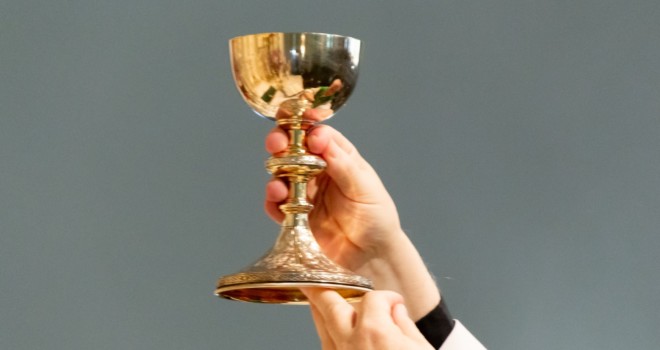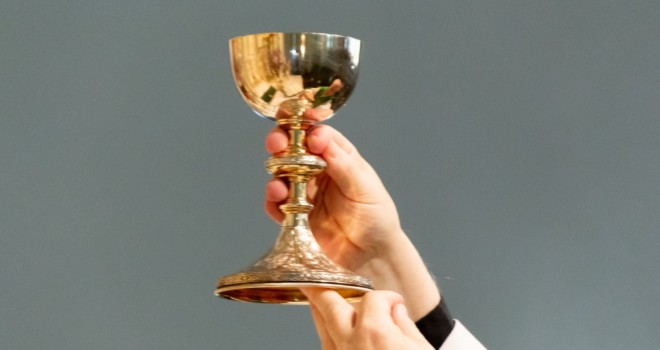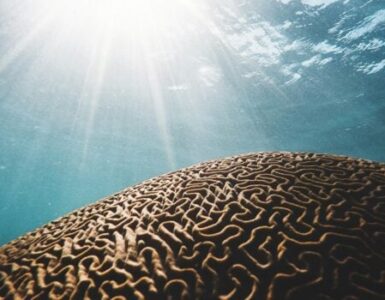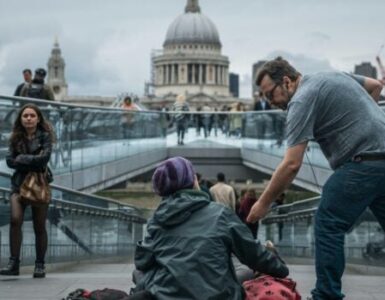The Mass has three important parts: the Offertory, the Consecration, and the Communion. In the order of human love, these correspond to engagement, the marriage ceremony, and the consummation of the marriage.
The Offertory
When a man becomes engaged to a woman, he generally brings her the gift of a precious ring; it is not of tin or straw, because these represent no sacrifice. Regardless of how much he might pay for the ring, he would still tear off the price tag. No matter how much he gave her, the gift to him would seem inadequate. The ring is round in order to express the eternity of his love which has neither beginning nor end; it is precious, because it is a symbol of the total readiness to give his whole personality to the beloved.
The Mass, too, has an engagement which corresponds to the Offertory of the Mass, in which the faithful bring gifts of bread and wine, or its equivalent, that which buys bread and wine. As the ring is a symbol of the lover offering himself to the beloved, so too, the bread and wine are the symbols of a person offering himself to Christ. This is apparent in several ways: first, since bread and wine have traditionally nourished man and given him life, in bringing that which was the substance of his life, he is equivalently giving himself.
Second, the readiness to sacrifice himself for the beloved is revealed in the bread and wine; no two substances have to undergo more to become what they are than do wheat and grapes. One passes through the Gethsemane of a mill, the other through the Calvary of the winepress before they can be presented to the Beloved on the altar. In the Offertory, therefore, under the appearance of bread and wine, the faithful are offering themselves to Christ.
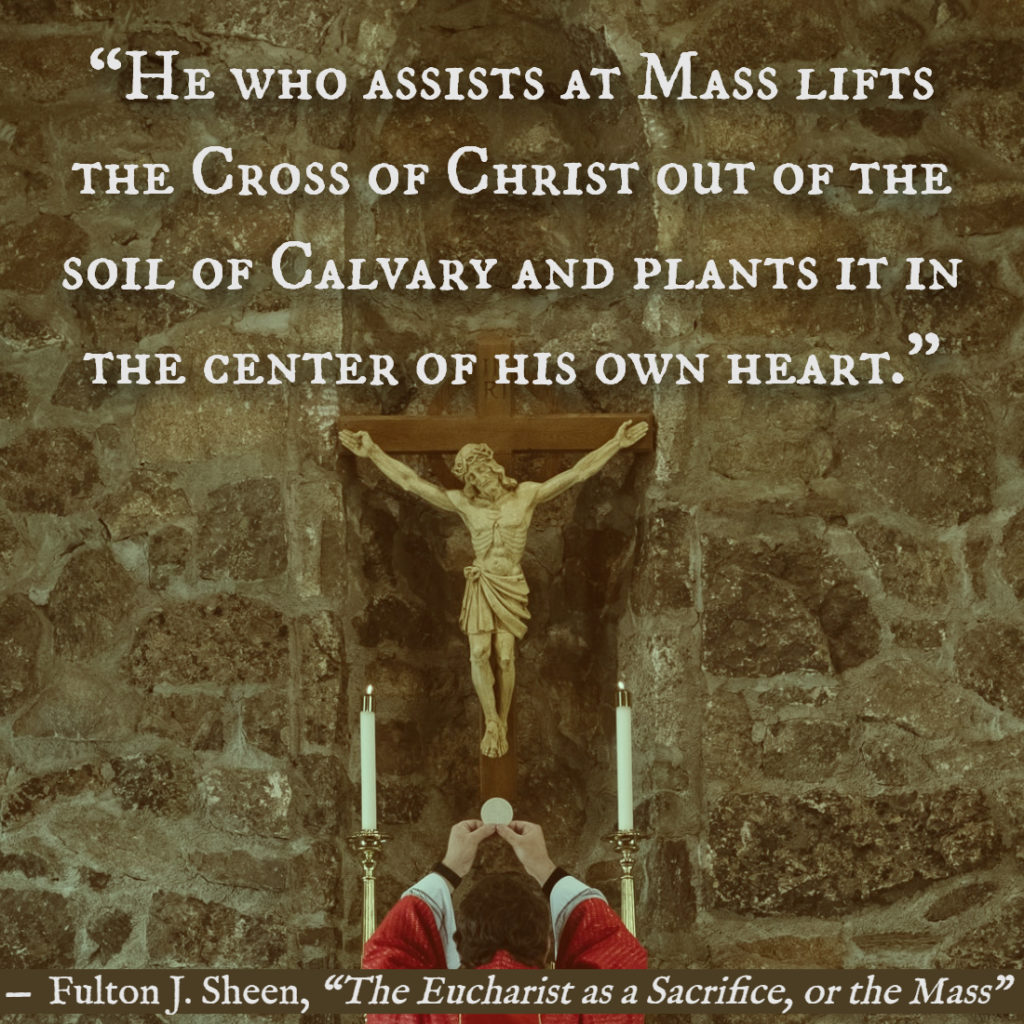
The Consecration
After the engagement comes the marriage ceremony in which the lover sacrifices himself for the beloved, and the beloved surrenders devotedly to the lover. The groom practically says, “My greatest freedom is to be your slave. I give up my individuality in order to serve you.” The joining of hands in the marriage ceremony is a symbol of the transfer of self to another self: “I am yours and you are mine. I want to die to myself, in order to live in you, my beloved. I cannot live unto you, unless I give up myself. So I say to you, ‘This is my body; this is my blood.’”
In the Mass, the faithful are already present on the altar under the appearance of bread and wine. At the moment of the Consecration of the Mass, when the priest as Christ pronounces the words “This is my Body” and “This is my Blood,” the substance of the bread becomes the substance of the Body of Christ, and the substance of the wine becomes the substance of the Blood of Christ. At that moment, the faithful are saying in a secondary sense with the priest: “This is my body; this is my blood. Take it! I no longer want it for myself. The very substance of my being, my intellect, and my will — change! Transubstantiate! — so that my ego is lost in Thee, so that my intellect is one with Thy Truth, and my will is one with Thy desires! I care not if the species or appearances of my life remain; that is to say, my duties, my avocation, my appointments in time and space. But what I am substantially, I give to Thee.”
Consummation & Communion
In the human order, after the engagement and the marriage is the consummation of the marriage. All love craves unity. Correspondence by letter, or by speech, cannot satisfy that instinctive yearning of two hearts to be lost in one another. There must, therefore, come some great ecstatic moment in which love becomes too deep for words.
The marital act is nothing but a fragile and shadowy image of Communion in which, after having offered ourselves under the appearance of bread and wine and having died to our lower self, we now begin to enjoy that ecstatic union with Christ in Holy Communion — a oneness which is, in the language of Thompson, “a passionless passion, a wild tranquility.” This is the moment when the hungry heart communes with the Bread of Life; this is the rapture in which is fulfilled that “love we fall just short of in all love,” and that rapture that leaves all other raptures pain.
The Sacrifice of the Mass may be presented under another analogy. Picture a house which had two large windows on opposite sides. One window looks down into a valley, the other to a towering mountain. The owner could gaze on both and somehow see that they were related: the valley is the mountain humbled; the mountain is the valley exalted.
The Sacrifice of the Mass is something like that. Every church, in a way, looks down on a valley, but the valley of death and humiliation in which we see a cross. But it also looks up to a mountain, an eternal mountain, the mountain of Heaven where Christ reigns gloriously. As the valley and the mountain are related as humiliation and exaltation, so the Sacrifice of the Mass is related to Calvary in the valley, and to Christ in Heaven and the eternal hills.
Time & Eternity
All three, Calvary, the Mass, and the glorified Christ in Heaven are different levels of the great eternal act of love. The Christ who appeared in Heaven as the lamb slain from the beginning of the world, at a certain moment in time, came to this earth and offered His Life in Redemption for the sins of men. True, agony and crucifixion are passing things, but the obedience and the love which inspired them are not. In the Father’s eyes, the Son-made-Man loves always unto death.
The Mass, therefore, looks backward and forward. Because we live in time and can use only earthly symbols, we see successively that which is but one eternal movement of love. If a motion picture reel were endowed with consciousness, it would see and understand the story at once; but we do not grasp it until we see it unfolded upon the screen. So it is with the love by which Christ prepared for His coming in the Old Testament, offered Himself on Calvary, and now re-presents it in Sacrifice in the Mass. The Mass, therefore, is not another immolation but a new presentation of the eternal Victim and its application to us. To assist at Mass is the same as to assist at Calvary. But there are differences.
On the Cross, our Lord offered Himself for all mankind; in the Mass we make application of that death to ourselves, and unite our sacrifice with His. The disadvantage of not having lived at the time of Christ is nullified by the Mass. On the Cross, He potentially redeemed all humanity; in the Mass we actualize that Redemption. Calvary happened at a definite moment in time and on a particular hill in space. The Mass temporalizes and spatializes that eternal act of love.
The Sacrifice of Calvary was offered up in a bloody manner by the separation of His blood from His body. In the Mass, this death is mystically and sacramentally presented in an unbloody manner, by the separate Consecration of bread and wine. The two are not consecrated together by such words as “This is my Body and my Blood”; rather, following the words of our Lord: “This is my Body” is said over the bread; then, “This is my Blood” is said over the wine. The separate Consecration is a kind of mystical sword dividing Body and Blood, which is the way our Lord died on Calvary.
Suppose there was an eternal broadcasting station that sent out eternal waves of wisdom and enlightenment. People who lived in different ages would tune in to that wisdom, assimilate it, and apply it to themselves. Christ’s eternal act of love is something to which we tune in, as we appear in successive ages of history through the Mass. The Mass, therefore, borrows its reality and its efficacy from Calvary and has no meaning apart from it. He who assists at Mass lifts the Cross of Christ out of the soil of Calvary and plants it in the center of his own heart.
This is the only perfect act of love, sacrifice, thanksgiving, and obedience which we can ever pay to God; namely, that which is offered by His Divine Son incarnate. Of and by ourselves, we cannot touch the ceiling because we are not tall enough. Of and by ourselves, we cannot touch God. We need a Mediator, someone who is both God and man, who is Christ. No human prayer, no human act of self-denial, no human sacrifice is sufficient to pierce Heaven. It is only the Sacrifice of the Cross that can do so, and this is done in the Mass. In the Mass we are once more at Calvary, rubbing shoulders with Mary Magdalen and John, while mournfully looking over our shoulders at executioners who still shake dice for the garments of the Lord.
Priest & Victim
The priest who offers the Sacrifice merely lends to Christ his voice and his fingers. It is Christ who is the Priest; it is Christ who is the Victim. In all pagan sacrifices and in the Jewish sacrifices, the victim was always separate from the priest. It might have been a goat, a lamb, or a bullock. But when Christ came, He the Priest offered Himself as the Victim. In the Mass, it is Christ who still offers Himself and who is the Victim to whom we become united.
The altar, therefore, is not related to the congregation as the stage to an audience in the theatre. The communion rail is not the same as footlights, which divide the drama from the onlooker. All the members of the Church have a kind of priesthood, inasmuch as they offer up with the Eternal Priest this eternal act of love. The laity participate in the life and power of Christ, for “Thou hast made us a royal race of priests to serve God” (Rev. 5:10).
The expression sometimes used by Catholics, “to hear Mass,” is an indication of how little is understood of their active participation, not only with Christ, but also with all of the saints and members of the Church until the end of time. This corporate action of the Church is indicated in certain prayers of the Mass.
All participate, but the closer we are to the mystery, the more we become one with Christ.
No man can ever come to the real fullness of his personality by reflection or contemplation; he has to act it out. That is why through all ages man laid his hand on the best of the herd and destroyed it in order to indicate the offering and surrender of himself. By laying his hands on the animal, he identified himself with it. Then he consumed it, in order to gain some identification with the one to whom it was offered. In the Mass, all the ancient dim foreshadowings of the supreme sacrifice are fulfilled.
Man immolates himself with Christ, bidding Him to take his body and his blood. Through this destruction of the ego, there is a void and an emptiness created, which makes it possible for the Divinity to fill up the vacuum and to make the offerer holy. Man dies to the past, in order that he may live in the future. He chooses to be united with his Divine King in some form of death, that he may share in His Resurrection and glory. Thus dying he lives; chastened he is not killed; sorrowful he always rejoices; giving up time, he finds eternity. Nothingness is exchanged for everything. Poverty turns into riches, and having nothing, he begins to possess all things.
✠
Editor’s note: This article is adapted from a chapter in the anthology, Archbishop Sheen’s Book of Sacraments. It is available as an ebook or paperback from your local Catholic bookstore or online through Sophia Institute Press.
Photo by Shalone Cason on Unsplash


